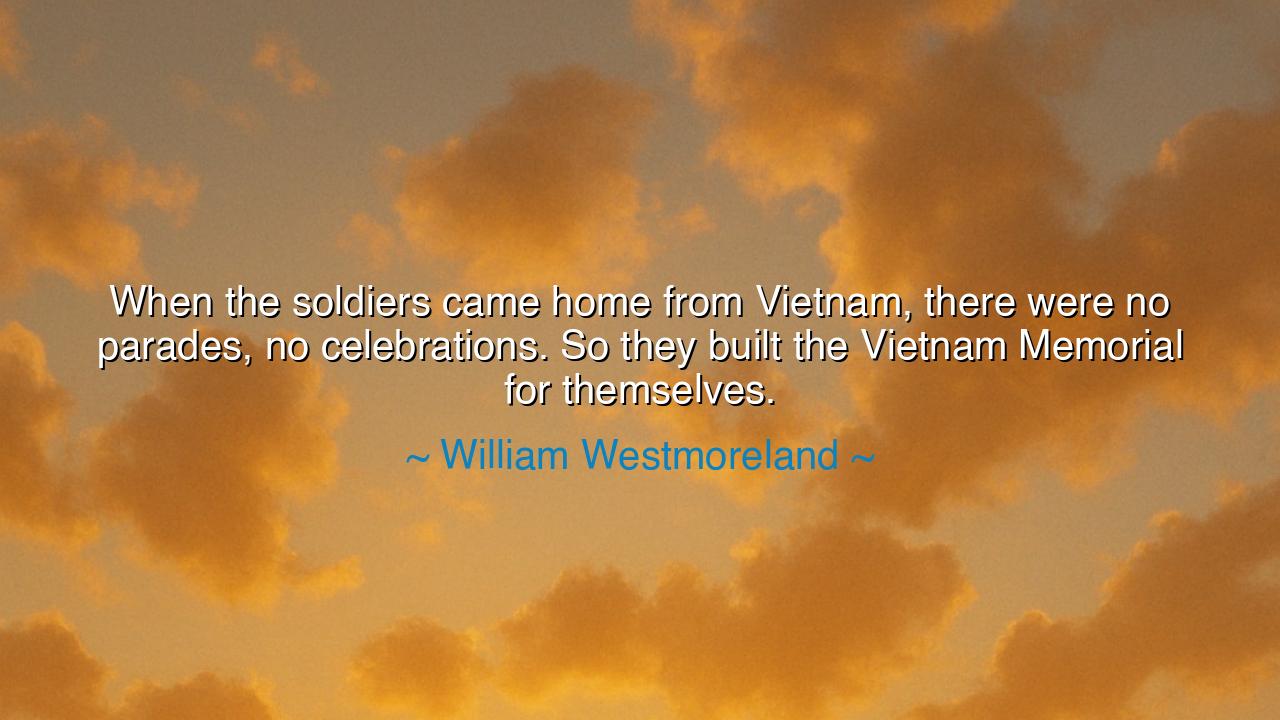
When the soldiers came home from Vietnam, there were no parades
When the soldiers came home from Vietnam, there were no parades, no celebrations. So they built the Vietnam Memorial for themselves.






In the hush that follows war, when banners are folded and drums forget their cadence, a stark truth is spoken: “When the soldiers came home from Vietnam, there were no parades, no celebrations. So they built the Vietnam Memorial for themselves.” Hear the ache and the iron in these words. The line is not a complaint so much as a chronicle: a people returning from fire to find no festival, and then choosing to forge their own altar of remembrance. Where the city offered no garland, the warriors planted a stone garden of names.
The ancients would have understood this grief. In older epics, returning fighters were met by trumpet and laurel; the polis reaffirmed the covenant: “We sent you forth; we receive you back.” But many who fought in Vietnam returned to a nation split and storming within itself. The unmade parade became a wound. Without the ritual that binds sacrifice to meaning, memory turns raw and restless. Westmoreland’s sentence records the remedy the veterans chose: if the rites are missing, make them. If the public square cannot speak, carve it a tongue of granite.
Out of that resolve rose a work as spare as a psalm: the Vietnam Memorial in Washington, D.C.—a long, dark V set into the earth, returning the gaze of the Lincoln Memorial and the Washington Monument. Its power is not in victory posed, but in absence named: more than fifty-eight thousand names incised, line after line, like rain that learned to write. A young architect—Maya Lin—drew it in quiet clarity, and veterans, led by their own effort and fundraising, willed it into being. Thus the unthrown celebrations became instead a place where the nation must look at itself, and in looking, learn to bow.
Consider the story of Jan Scruggs, an infantryman haunted by the dead who did not come home with him. After the war, he set himself to the unlikely task of building a national memorial—organizing, persuading, enduring scorn and controversy over design and meaning. Yet he persisted, and others with him; they raised the funds, won the approvals, and bore the quarrels until the wall stood. When the first fingertips found the first names, when paper rubbings blackened with graphite tears, a new ritual appeared where none had been offered. The soldiers, denied a parade, gave themselves a pilgrimage.
There is a stern wisdom in this: remembrance is not a luxury appended to war; it is the last battle of the war, the struggle to rescue meaning from noise. A parade cheers for an hour; a wall instructs for generations. The memorial does not argue; it witnesses. It does not demand applause; it demands attention. And as visitors descend along the granite—seeing their own faces reflected among the names—the living are conscripted into gentleness. The wall teaches with a teacher’s voice: reckon with the cost, and let the reckoning make you careful with the lives of others.
Yet the wall is also an act of mercy toward the living. Those who carried shame not their own found there a counter-ritual: instead of heckles, the hush of a national cemetery’s wind; instead of celebrations they could not bear, the tender labor of tracing a friend’s name and telling a story. In this way the memorial became a shared work of mourning, a bridge between those who fought and those who only argued about the fighting. It is a place where ideology runs out of breath and love continues walking.
Take the lesson and bind it to the heart: when the world withholds honor, create honest honor; when the chorus fails, build a chapel. Practical ways to keep faith: (1) Visit such places—walls, fields, stones—and bring a young person to hear a veteran’s story. (2) Learn a single name and the small life it contained; let remembrance be specific, not abstract. (3) Support the healing work—mental health care, family aid, community rites—so that no one must build their memorial alone. (4) In times of division, choose rituals that gather rather than scatter: moments where silence and gratitude can do what speeches cannot. For travelling back to such memorial ground, we find again what Westmoreland’s words imply: when honor is missing, love must lay the foundation—and from that foundation, a nation relearns how to stand.






AAdministratorAdministrator
Welcome, honored guests. Please leave a comment, we will respond soon